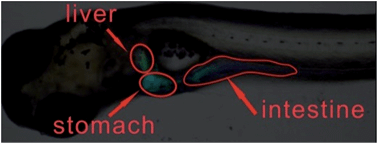A ratiometric fluorescent probe for in vivo tracking of alkaline phosphatase level variation resulting from drug-induced organ damage†
Abstract
Clinical drug-induced organ toxicity and damage have been recognized as an important public health issue, and an effective approach capable of in vivo detection of biomarkers resulting from drug-induced organ damage is being actively pursued. Herein, we demonstrate a ratiometric fluorescent probe that can trace the variation in alkaline phosphatase (ALP, an organ damage biomarker) levels spatially in vivo. The probe was synthesized by incorporating a phosphate group and an amine-N-oxide group on a 1,8-naphthalimide derivative. The presence of ALP cleaves the phosphate group from naphthalimide and remarkably alters the probe's photophysical properties, thus achieving ratiometric detection of ALP. The incorporation of amine-N-oxide ensures excellent water solubility and biocompatibility, which guarantees the ratiometric detection of ALP in aqueous media and in the cells overexpressed with ALP. With a detection limit of 0.38 U L−1, the probe was successfully used in detecting ALP in human serum samples. Moreover, the probe can be employed to monitor and spatially map the endogenous variation in ALP levels in zebrafishes. This is the first observation, to our knowledge, of organ-scale ALP pattern in vivo as a result of clinical drug (APAP) induced damage.


 Please wait while we load your content...
Please wait while we load your content...